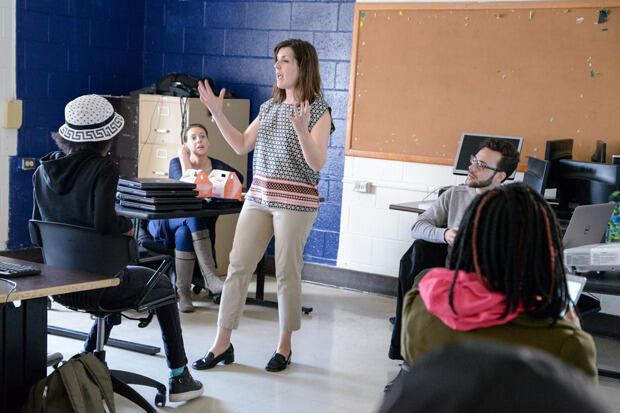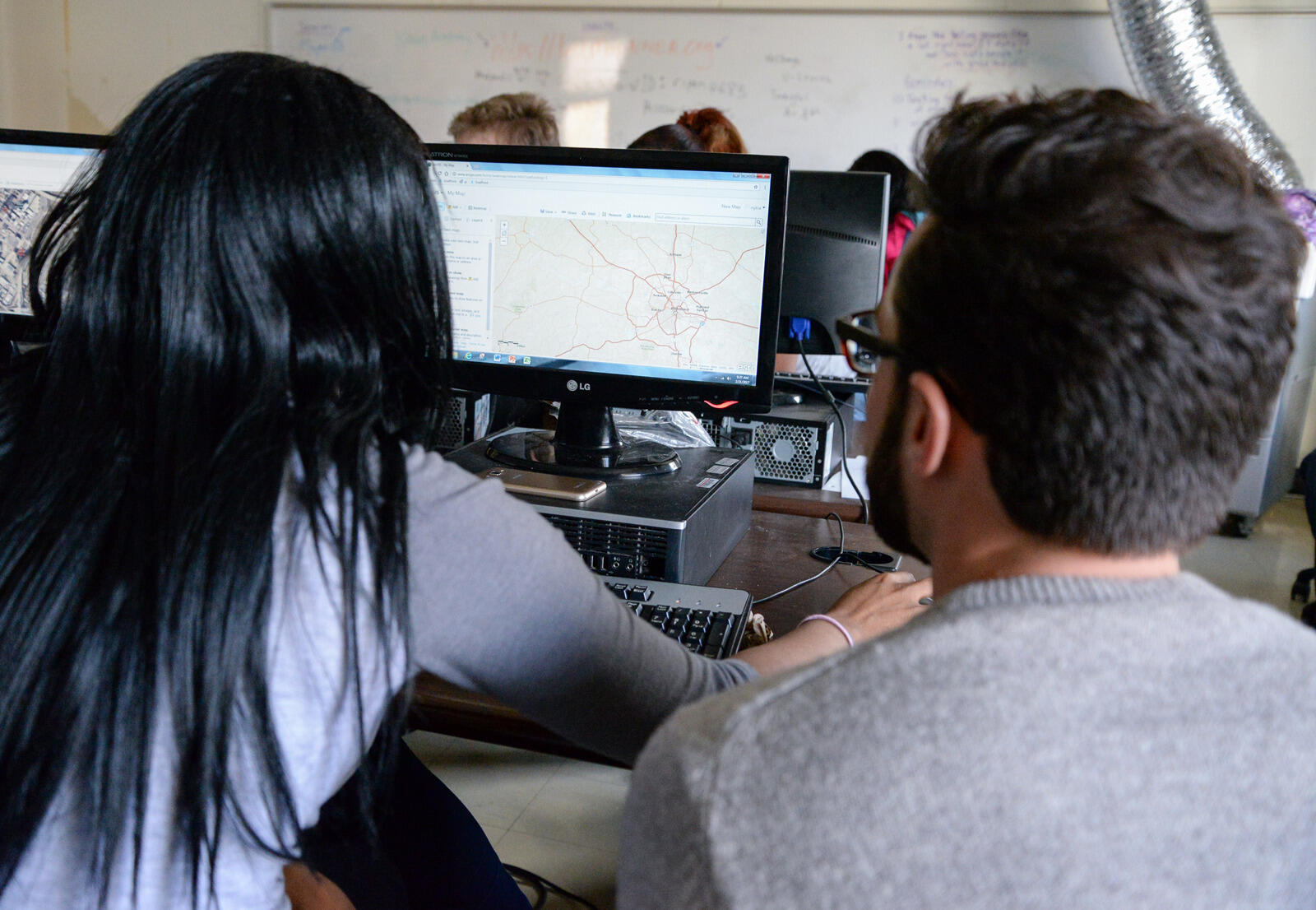
<br>Photos by Pat Kane, University Public Affairs
March 3, 2017
Armstrong HS students, VCU researchers to develop community stormwater map
Share this story
At the head of an Armstrong High School computer lab, a visitor had a question for a group of students. “Where does it flood and become a mess when it rains heavily?”
“Down the street from Martin Luther King Middle, at the store,” one Armstrong student said. “It fills up when it rains!”
“The bottom of the hill, where it just floods,” another said.
“It floods right here,” said a student pointing out the window.
“You guys are the experts. Tell us where you want to put stuff to reduce runoff,” said Jennifer Ciminelli, research and data coordinator for the Rice Rivers Center and faculty in VCU’s Center for Environmental Studies.
These students know their community best, and that’s why they are working with Virginia Commonwealth University researchers to develop a greening plan for downtown Richmond. The plan, which is part of an EPA grant-funded project, will address water runoff pollution in the Jackson Ward, Monroe Ward and Carver neighborhoods and in the areas of VCU’s Monroe Park and MCV campuses.

The project team took over Lauren Kern’s biology class one morning.
Ciminelli began with a brief mindfulness exercise, since it can be stressful working with computers and their inevitable quirks and crashes. Then, the projector lit up for an overview of geographic information systems and the types of data they can incorporate visually. Vacant buildings, parking lots, underground infrastructure, topography and other information layer the map as she embeds datasets.
With this information meshed together, students can search, for instance, for an underutilized lot that could become a community garden, pocket park or other asset to benefit the community and the James River.
Jonet Prevost-White, operations manager with the Richmond Department of Public Utilities, discussed the relationship between litter, pollutants, sewage treatment and the river. The class also looked at community projects that have helped clean up the city. Water running along hard surfaces can sweep pollutants into the river, whereas rain gardens, permeable pavers and other solutions allow water to seep into the ground.
“This is what this grant is all about – to keep the water clean,” she said.
|
Community Meetings This Month *Jackson Ward: Tuesday, March 21 at 6 p.m.
|
Students looked at a map of the James River, noting a large red area showing impairment past downtown. A student asked what a thin green line, superimposed through Shockoe Bottom on the map, represented. It showed a stream buried generations ago, said Prevost-White, and water flowing from Armstrong’s grounds will eventually go into the mammoth pipes that contain the stream.
Students then logged in and created their own ArcGIS Online accounts. The platform will allow them to talk with their family and neighbors, logging in to their maps to tag problem areas and propose solutions. Ciminelli ran through the steps to load useful datasets as Wyatt Carpenter and Sara Chonja, research associates for the project, circled the room helping students.Students looked at a map of the James River, noting a large red area showing impairment past downtown. A student asked what a thin green line, superimposed through Shockoe Bottom on the map, represented. It showed a stream buried generations ago, said Prevost-White, and water flowing from Armstrong’s grounds will eventually go into the mammoth pipes that contain the stream.

“We actually want to make a map and say, ‘Here are all the spots that are problems.’ Then we want to help people find money to work on projects with the neighborhoods,” Ciminelli said.
As part of the project, organizers will attend community meetings with the neighborhood associations of Carver, Jackson Ward and Monroe Ward to show the map and receive feedback.
The VCU Division of Community Engagement will provide assistance.
VCU is the only grant recipient in Virginia, with 22 projects underway nationwide.
Subscribe for free to the VCU News email newsletter at http://newsletter.news.vcu.edu/ and receive a selection of stories, videos, photos, news clips and event listings in your inbox every Monday and Thursday.
Subscribe to VCU News
Subscribe to VCU News at newsletter.vcu.edu and receive a selection of stories, videos, photos, news clips and event listings in your inbox.









